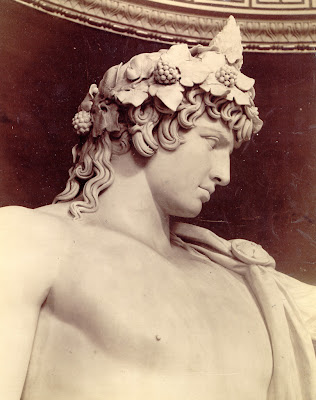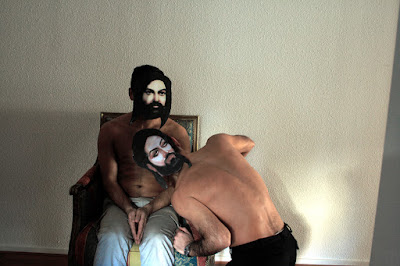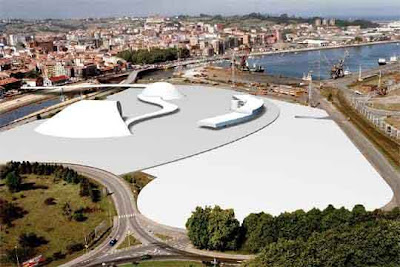
Antinous
The rain outside was cold in Hadrian’s soul.
The boy lay dead
On the low couch, on whose denuded whole,
To Hadrian’s eyes, whose sorrow was a dread,
The shadowy light of Death’s eclipse was shed.
The boy lay dead, and the day seemed a night
Outside. The rain fell like a sick affright
Of Nature at her work in killing him.
Memory of what he was gave no delight,
Delight at what he was was dead and dim.
O hands that once had clasped Hadrian’s warm hands,
Whose cold now found them cold!
O hair bound erstwhile with the pressing bands!
O eyes half-diffidently bold!
O bare female male-body such
As a god’s likeness to humanity!
O lips whose opening redness erst could touch
Lust's seats with a live art's variety!
O fingers skilled in things not to be told!
O tongue which, counter-tongued, made the blood bold!
O complete regency of lust throned on
Raged consciousness’s spilled suspension!
These things are things that now must be no more.
The rain is silent, and the Emperor
Sinks by the couch. His grief is like a rage,
For the gods take away the life they give
And spoil the beauty they made live.
He weeps and knows that every future age
Is looking on him out of the to-be;
His love is on a universal stage;
A thousand unborn eyes weep with his misery.
Antinous is dead, is dead for ever,
Is dead for ever and all loves lament.
Venus herself, that was Adonis’ lover,
Seeing him, that newly lived, now dead again,
Lends her old grief’s renewal to be blent
With Hadrian’s pain.
Now is Apollo sad because the stealer
Of his white body is for ever cold.
No careful kisses on that nippled point
Covering his heart-beats’ silent place restore
His life again to ope his eyes and feel her
Presence along his veins Love’s fortress hold.
No warmth of his another’s warmth demands.
Now will his hands behind his head no more
Linked, in that posture giving all but hands,
On the projected body hands implore.
The rain falls, and he lies like one who hath
Forgotten all the gestures of his love
And lies awake waiting their hot return.
But all his arts and toys are now with Death.
This human ice no way of heat can move;
These ashes of a fire no flame can burn.
O Hadrian, what will now thy cold life be?
What boots it to be lord of men and might?
His absence o’er thy visible empery
Comes like a night,
Nor is there morn in hopes of new delight.
Now are thy nights widowed of love and kisses;
Now are thy days robbed of the night’s awaiting;
Now have thy lips no purpose for thy blisses,
Left but to speak the name that Death is mating
With solitude and sorrow and affright.
Thy vague hands grope, as if they had dropped joy.
To hear that the rain ceases lift thy head,
And thy raised glance take to the lovely boy.
Naked he lies upon that memoried bed;
By thine own hand he lies uncoverèd.
There was he wont thy dangling sense to cloy,
And uncloy with more cloying, and annoy
With newer uncloying till thy senses bled.
His hand and mouth knew games to reinstall
Desire that thy worn spine was hurt to follow.
Sometimes it seemed to thee that all was hollow
In sense in each new straining of sucked lust.
Then still new turns of toying would he call
To thy nerves’ flesh, and thou wouldst tremble and fall
Back on thy cushions with thy mind’s sense hushed.
»Beautiful was my love, yet melancholy.
He had that art, that makes love captive wholly,
Of being slowly sad among lust’s rages.
Now the Nile gave him up, the eternal Nile.
Under his wet locks Death’s blue paleness wages
Now war upon our wishing with sad smile.«
Even as he thinks, the lust that is no more
Than a memory of lust revives and takes
His senses by the hand, his felt flesh wakes,
And all becomes again what ’twas before.
The dead body on the bed starts up and lives
And comes to lie with him, close, closer, and
A creeping love-wise and invisible hand
At every body-entrance to his lust
Whispers caresses which flit off yet just
Remain enough to bleed his last nerve’s strand,
O sweet and cruel Parthian fugitives!
So he half rises, looking on his lover,
That now can love nothing but what none know.
Vaguely, half-seeing what he doth behold,
He runs his cold lips all the body over.
And so ice-senseless are his lips that, lo!,
He scarce tastes death from the dead body’s cold,
But it seems both are dead or living both
And love is still the presence and the mover.
Then his lips cease on the other lips’ cold sloth.
Ah, there the wanting breath reminds his lips
That from beyond the gods hath moved a mist
Between him and this boy. His finger-tips,
Still idly searching o’er the body, list
For some flesh-response to their waking mood.
But their love-question is not understood:
The god is dead whose cult was to be kissed!
He lifts his hand up to where heaven should be
And cries on the mute gods to know bis pain.
Let your calm faces turn aside to his plea,
O granting powers! He will yield up his reign.
In the still deserts he will parchèd live,
In the far barbarous roads beggar or slave,
But to his arms again the warm boy give!
Forego that space ye meant to be his grave!
Take all the female loveliness of earth
And in one mound of death its remnant spill!
But, by sweet Ganymede, that Jove found worth
And above Hebe did elect to fill
His cup at his high feasting, and instil
The friendlier love that fills the other’s dearth,
The clod of female embraces resolve
To dust, o father of the gods, but spare
This boy and his white body and golden hair!
Maybe thy better Ganymede thou feel’st
That he should be, and out of jealous care
From Hadrian’s arms to thine his beauty steal’st.
He was a kitten playing with lust, playing
With his own and with Hadrian’s, sometimes one
And sometimes two, now linking, now undone;
Now leaving lust, now lust’s high lusts delaying;
Now eying lust not wide, but from askance
Jumping round on lust’s half-unexpectance;
Now softly gripping, then with fury holding,
Now playfully playing, now seriously, now lying
By th’ side of lust looking at it, now spying
Which way to take lust in his lust’s withholding.
Thus did the hours slide from their tangled hands
And from their mixèd limbs the moments slip.
Now were his arms dead leaves, now iron bands;
Now were his lips cups, now the things that sip;
Now were his eyes too closed and now too looking;
Now were his uncontinuings frenzy working;
Now were his arts a feather and now a whip.
That love they lived as a religion
Offered to gods that come themselves to men.
Sometimes he was adorned or made to don
Half-vestures, then in statued nudity
Did imitate some god that seems to be
By marble’s accurate virtue men's again.
Now was he Venus, white out of the seas;
And now was he Apollo, young and golden;
Now as Jove sate he in mock judgement over
The presence at his feet of his slaved lover;
Now was he an acted rite, by one beholden,
In ever-repositioned mysteries.
Now he is something anyone can be.
O stark negation of the thing it is!
O golden-haired moon-cold loveliness!
Too cold! too cold! and love as cold as he!
Love through the memories of his love doth roam
As through a labyrinth, in sad madness glad,
And now calls on his name and bids him come,
And now is smiling at his imaged coming
That is i’th’ heart like faces in the gloaming –
Mere shining shadows of the forms they had.
The rain again like a vague pain arose
And put the sense of wetness in the air.
Suddenly did the Emperor suppose
He saw this room and all in it from far.
He saw the couch, the boy, and his own frame
Cast down against the couch, and he became
A clearer presence to himself, and said
These words unuttered, save to his soul’s dread:
»I shall build thee a statue that will be
To the continued future evidence
Of my love and thy beauty and the sense
That beauty giveth of divinity.
Though death with subtle uncovering hands remove
The apparel of life and empire from our love,
Yet its nude statue, that thou dost inspirit,
All future times, whether they will’t or not,
Shall, like a gift a forcing god hath brought,
Inevitably inherit.
»Ay, this thy statue shall I build, and set
Upon the pinnacle of being thine, that Time
By its subtle dim crime
Will fear to eat it from life, or to fret
With war’s or envy’s rage from bulk and stone.
Fate cannot be that! Gods themselves, that make
Things change, Fate’s own hand, that doth overtake
The gods themselves with darkness, will draw back
From marring thus thy statue and my boon,
Leaving the wide world hollow with thy lack.
»This picture of our love will bridge the ages.
It will loom white out of the past and be
Eternal, like a Roman victory,
In every heart the future will give rages
Of not being our love’s contemporary.
»Yet oh that this were needed not, and thou
Wert the red flower perfuming my life,
The garland on the brows of my delight,
The living flame on altars of my soul!
Would all this were a thing thou mightest now
Smile at from under thy death-mocking lids
And wonder that I should so put a strife
Twixt me and gods for thy lost presence bright;
Were there nought in this but my empty dole
And thy awakening smile half to condole
With what my dreaming pain to hope forbids.«
Thus went he, like a lover who is waiting,
From place to place in this dim doubting mind.
Now was his hope a great intention fating
Its wish to being, now felt he he was blind
In some point of his seen wish undefined.
When love meets death we know not what to feel.
When death foils love we know not what to know.
Now did his doubt hope, now did his hope doubt;
Now what his wish dreamed the dream’s sense did flout
And to a sullen emptiness congeal.
Then again the gods fanned love’s darkening glow.
»Thy death has given me a higher lust –
A flash-lust raging for eternity.
On mine imperial fate I set my trust
That the high gods, that made me emperor be,
Will not annul from a more real life
My wish that thou should’st live for e’er and stand
A fleshly presence on their better land,
More lovely yet not lovelier, for there
No things impossible our wishes mar
Nor pain our hearts with change and time and strife.
»Love, love, my love! thou art already a god.
This thought of mine, which I a wish believe,
Is no wish, but a sight, to me allowed
By the great gods, that love love and can give
To mortal hearts, under the shape of wishes –
Of wishes having undiscovered reaches –,
A vision of the real things beyond
Our life-imprisoned life, our sense-bound sense.
Ay, what I wish thee to be thou art now
Already. Already on Olympic ground
Thou walkest and art perfect, yet art thou,
For thou needst no excess of thee to don
Perfect to be, being perfection.
»My heart is singing like a morning bird.
A great hope from the gods comes down to me
And bids my heart to subtler sense be stirred
And think not that strange evil of thee
That to think thee mortal would be.
»My love, my love, my god-love! Let me kiss
On thy cold lips thy hot lips now immortal,
Greeting thee at Death’s portal’s happiness,
For to the gods Death’s portal is Life’s portal.
»Were no Olympus yet for thee, my love
Would make thee one, where thou sole god mightst prove,
And I thy sole adorer, glad to be
Thy sole adorer through infinity.
That were a universe divine enough
For love and me and what to me thou art.
To have thee is a thing made of gods’ stuff
And to look on thee eternity’s best part.
»But this is true and mine own art: the god
Thou art now is a body made by me,
For, if thou art now flesh reality
Beyond where men age and night cometh still,
’Tis to my love’s great making power thou owest
That life thou on thy memory bestowest
And mak’st it carnal. Had my love not held
An empire of my mighty legioned will,
Thou to gods’ consort hadst not been compelled.
»My love that found thee, when it found thee did
But find its own true body and exact look.
Therefore when now thy memory I bid
Become a god where gods are, I but move
To death’s high column’s top the shape it took
And set it there for vision of all love.
»O love, my love, put up with my strong will
Of loving to Olympus, be thou there
The latest god whose honey-coloured hair
Takes divine eyes! As thou wert on earth, still
In heaven bodyfully be and roam,
A prisoner of that happiness of home,
With elder gods, while I on earth do make
A statue for thy deathlessness’ seen sake.
»Yet thy true deadless statue I shall build
Will be no stone thing, but that same regret
By which our love’s eternity is willed.
One side of that is thou, as gods see thee
Now, and the other, here, thy memory.
My sorrow will make that men’s god, and set
Thy naked memory on the parapet
That looks upon the seas of future times.
Some will say all our love was but our crimes;
Others against our names the knives will whet
Of their glad hate of beauty’s beauty, and make
Our names a base of heap whereon to rake
The names of all our brothers with quick scorn.
Yet will our presence, like eternal Morn,
Ever return at Beauty’s hour, and shine
Out of the East of Love, in light to enshrine
New gods to come, the lacking world to adorn.
»All that thou art now is thyself and I.
Our dual presence has its unity
In that perfection of body which my love,
By loving it, became, and did from life
Raise into godness, calm above the strife
Of times, and changing passions far above.
»But since men see more with the eyes than soul,
Still I in stone shall utter this great dole;
Still, eager that men hunger by thy presence,
I shall to marble carry this regret
That in my heart like a great star is set.
Thus, even in stone, our love shall stand so great
In thy statue of us, like a god’s fate,
Our love’s incarnate and discarnate essence,
That, like a trumpet reaching over seas
And going from continent to continent,
Our love shall speak its joy and woe, death-blent,
Over infinities and eternities.
»And here, memory or statue, we shall stand,
Still the same one, as we were hand in hand
Nor felt each other’s hand for feeling feeling.
Men still will see me when thy sense they take.
The entire gods might pass in the vast wheeling
Of the globed ages. If but for thy sake,
That, being theirs, hadst gone with their gone band,
They would return, as they had slept to wake.
»Then the end of days when Jove were born again
And Ganymede again pour at his feast
Would see our dual soul from death released
And recreated unto joy, fear, pain –
All that love doth contain;
Life – all the beauty that doth make a lust
Of love’s own true love, at the spell amazed;
And, if our very memory wore to dust,
By some gods’ race of the end of ages must
Our dual unity again be raised.«
It rained still. But slow-treading night came in,
Closing the weary eyelids of each sense.
The very consciousness of self and soul
Grew, like a landscape through dim raining, dim.
The Emperor lay still, so still that now
He half forgot where now he lay, or whence
The sorrow that was still salt on his lips.
All had been something very far, a scroll
Rolled up. The things he felt were like the rim
That haloes round the moon when the night weeps.
His head was bowed into his arms, and they
On the low couch, foreign to his sense, lay.
His closed eyes seemed open to him, and seeing
The naked floor, dark, cold, sad and unmeaning.
His hurting breath was all his sense could know.
Out of the falling darkness the wind rose
And fell; a voice swooned in the courts below;
And the Emperor slept.
And the Emperor slept.The gods came now
And bore something away, no sense knows how,
On unseen arms of power and repose.
Fernando Pessoa en 1918 publicó dos poemas en inglés Antinous y 35 Sonnets que en septiembre fueron objeto de la crítica inglesa en los diarios Times y Glasgow Herald












 Enlaces:
Enlaces: Desde 27.11.2007 - 26.01.2008 en la Galería Mito se exponen "The Fall" de Anthony Gayton.
Desde 27.11.2007 - 26.01.2008 en la Galería Mito se exponen "The Fall" de Anthony Gayton.










